



Ciencias Técnicas
The Second Philadelphia Water Works and the aqueduct Fernando VII in Havana
El segundo sistema hidráulico de la ciudad de Filadelfia y el Acueducto Fernando VII en La Habana
Anales de la Academia de Ciencias de Cuba
Academia de Ciencias de Cuba, Cuba
ISSN-e: 2304-0106
Periodicity: Cuatrimestral
vol. 11, no. 3, e1002, 2021
Received: 25 March 2021
Accepted: 13 July 2021
Corresponding author: revistaacc@academiaciencias.cu
Abstract: Introduction: The city of Philadelphia in the United States of America was an important center for the development of the industrial revolution and capitalism in that country. In the 1820´s, it finally got an efficient first-class aqueduct that produced clean and cheap water. The Philadelphia waterworks inspired the construction of Fernando VII aqueduct in Havana and the foundries of the US city supplied the pipes and other elements used in the works. Objectives: To describe the process of construction of the waterworks of the city of Philadelphia in the early decades of the XIX century, to explain the influence of the second Philadelphia waterworks upon the construction of Fernando VII aqueduct in Havana through the changes of the original project made by Nicolas Campos, to characterize Fernando VII aqueduct. Methods: Bibliographical review and document review at the National Archive of the Republic of Cuba, observation and photography. Results: The achievement of Fernando VII aqueduct in Havana was to a great extent the result of the influence of the second waterworks of the city of Philadelphia and the economic perspective of the Watering Committee and the City Council of that city. The new aqueduct in Havana introduced plumbing in Cuba, allowing for the use of flowing water inside the buildings and improving the hygiene of the city. Even when the Albear waterworks was inaugurated in 1893, the plan of that engineer was to use most of the distribution system of Fernando VII aqueduct to distribute its water. Some of these ancient pipes are still in use in Havana.
Keywords: aqueduct, waterworks, distribution system, iron pipes, plumbing, economic management.
Resumen:
Introducción: La ciudad de Filadelfia en los Estados Unidos de América fue un centro im- portante en el desarrollo de la revolución industrial y el capitalismo en ese país. En los años 20 del siglo XIX alcanzó a tener finalmente un acueducto eficiente de primera clase que la proveyó de agua barata y limpia. El sistema hidráulico de esta ciudad inspiró la construcción del acueducto Fernando VII en La Habana, comenzado a construir según un paradigma dife- rente. Las fundiciones de Filadelfia suplieron a La Habana con las tuberías de hierro y otras piezas metálicas necesarias para la obra. Objetivos: Describir el proceso de construcción de los sistemas hidráulicos de la ciudad de Filadelfia en las tres primeras décadas del siglo XIX, explicar la influencia del segundo sistema hidráulico de la ciudad de Filadelfia en la construcción del acueducto Fernando VII en La Habana a través de los cambios efectuados por Nicolás Campos al proyecto original, caracterizar el acueducto Fernando VII en La Habana. Métodos: Revisión bibliográfica y consulta de documentos en el Archivo Nacional de la República de Cuba, observación y fotografía. Resultados: El resultado obtenido en la construcción del acueducto Fernando VII fue en buena medida gracias a la influencia del segundo sistema hidráulico de la ciudad de Filadelfia y las perspectivas económicas del Comité para el agua y del Consejo de aquella ciudad. El acueducto significó la introducción de la plomería en Cuba, permitiendo el uso de agua corriente dentro de los edificios y mejorando la higiene en la ciudad. Aun cuando el acueducto de Albear fue inaugurado en 1893, este ingeniero planeó que el sistema de distribución del acueducto Fernando VII fuera empleado para distribuir el agua de su obra. Un número impreciso pero significativo de estas tuberías de hierro permanecen en uso en La Habana.
Palabras clave: acueducto, tuberías de hierro, plomería, gestión económica .
INTRODUCTION
A bronze statue of Jose Marti, the Cuban national hero, was inaugurated in the 13 de marzo park in Old Havana on January 28th, 2018. Anna Hyatt Huntington, the famous sculptor, created the original bronze statue placed in Central Park, New York city in 1950. Despite of the trend in the political relationship between Cuba and the United States of America tho- se days, that was an act of good faith and friendship based upon historical and cultural bases. The copy of the original bronze was cast in the city of Philadelphia in 2017 but this was not the first time our cities participate in conjoint projects. This report deals with the relationship between Philadelphia and Havana in the XIX century regarding a revolution in water management.
The city of Philadelphia in the United States of America was an important center in the development of the industrial revolution and capitalism in that country. In the 20´s of the XIX century it finally got a first class, efficient water work that produced clean and cheap water for those connected to the aqueduct and free water in the fountains and hydrants in the streets. The Philadelphia Water Works inspired important changes in the original project of construction of a new aqueduct in Havana and the foundries of the city supplied the pipes and other elements used in the works.
To describe the process of construction of the Water Works of the city of Philadelphia in the early decades of the XIX century.
To explain the influence of the Second Philadelphia Water Works upon the construction of the aqueduct Fernando VII in Havana through the changes of the original project made by Nicolas Campos.
To characterize the Fernando VII aqueduct.
METHODS
The present paper started with the bibliographic review about the construction of both, the aqueduct of the city of Philadelphia and the one known as Fernando VII in Havana. Regarding the aqueduct of Havana, the most prominent authors were Jacobo de la Pezuela, Francisco de Albear y Lara, Abel Fernandez Simon, Luis Morales Pedroso, Ignacio Gonzalez Tascon, Levi Marrero, Felicia Chateloin, Rolando Garcia Blanco and Alfredo Alvarez Hernandez; regarding the city of Philadelphia the authors consulted were Lynn Miller, Adam Levine and the papers produced by the Philadelphia Water Department.
In a second moment of the research we consulted a lot of documents at the National Archive of the Republic of Cuba, in the Collections Intendencia General de Hacienda and Gobierno Superior Civil. We have the opportunity of consulting some documents of the Philadelphia Water Works that are uploaded in Internet by the Philadelphia Water Department.
In order to obtain information about the iron pipes we also prospected different locations in Havana where the aqueduct is still in use, applying the observation as a method and the photography as a technique.
RESULTS
William Penn founded in 1682 the city of Philadelphia, one of the most important cities in the British empire and the Thir-
teen colonies. The city grew very fast and became one of the centers of the revolution that free the colonies from England. In 1787 it became the first capital of the United States, (1)
In the beginning the inhabitants of the city used springs and wells to obtain the water they needed. The construction of privy pits generated the contamination of those sources with the consequent health problems for the people. (1)
Between 1793 and 1798 several epidemics of yellow fever occurred and lots of citizens died. A new source of water was necessary to prevent new mortal outbreaks and also to provide water enough to fight fires. (2)
In 1798 the city decided to construct water works under the design of Benjamin Latrobe, who also supervised the construction. This first aqueduct was finished in the beginning of 1801 and it took water from the river Schuylkill. The system had two pumping stations moved by steam engines: one in the river and another in the Center Square where wooden tanks on top of a building collected 67,000 liters (67.00 cubic meters). From those tanks the water flowed through a system of wooden pipes to the city by gravity. Some iron pipes were installed then but they resulted very expensive and difficult to obtain. (2,3)
It is important to emphasize that the property of the whole system was public and no subject of any kind of speculation; a long number of hydrants and fountains were located in the streets of the city to which people had free access. The city used the water to clean the streets and to extinguish fires. In the other hand, every householder could have a hydrant everywhere in their buildings even on top stories, by paying a low price for the service. The abundance of water inside the households improved the hygiene for the people of the city. (4) The system that Latrobe constructed started to go wrong due to the frequent fail of the steam engines and the tanks fed the city for only 25 minutes when there was no pumping. In 1811 Frederick Graff was the superintendent of the water system and took the responsibility of improving it, charged by the Watering Committee of the city. (5)
The first decision taken was to construct larger facilities in Fairmount on the shores of the river Schuylkill, about a mile upstream from the original location. They placed a new pum- ping station with two steam engines, one helping as a back-up to the other. On top of the hill they constructed a large reser- voir with the capacity of three million gallons (11,356 cubic meters). From the heights of the new reservoir, 56 feet (17 meters) above the highest ground in the city, water flew by gravity into the active system of pipes. This new system greatly enlarged the one established by Latrobe in the original water works: pumping water to elevated storage and distribution by gravity flow. The works finished in 1815. (5)
Due to the use of wooden pipes the water pressure diminished more than anticipated, a problem for several users at the far end of the pipelines. The Watering Committee decided in 1818 to lay only iron pipes (Fig. 1). Over the next decades the committee laid only new cast iron pipes until 1858, when they took out of service the last wooden pipes. In 1823 the distribution system counted with 11 000 meters of iron pipes through the city. (6) The cast iron pipes had less friction, leaked less readily, and lasted far longer than the wooden ones. Some iron pipes laid in the 1820s are still in service in the oldest parts of Philadelphia. (5)
In second place Graff eliminated the steam engines for a new system that used the power of the Schuylkill river to pump the water to Fairmount. They constructed a dam in the river and a mill house which housed water wheels, each of 15 feet (4,6 meters) wide and more or less the same in diameter. The wheels turned at 11 to 14 revolutions per minute and its power moved a pump that pushed the water through a pipe to the reservoir at Fairmount. In 1822 Graff stopped the steam engines and three wheels took their place, but in 1843 the number of wheels was raised to eight. (5)
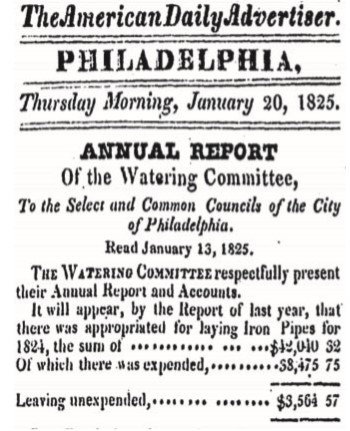
The Water Works provided in 1844 the amount of 20 million of liters a day (20 000 cubic meters) to 28 082 users. That year the expenses of the aqueduct were of $ 29 713,00 and the incomes were of $ 151 501,00 (7), showing that the management of the aqueduct was successful. Frederick Graff´s design of Fairmount Water Works were pioneer regarding the connection of technology, natural resources and environment. The Palladian architecture of the buildings, the landscape gardens, the promenades, the river and the technological advances applied there were an attraction for many visitors. Due to the contamination of the river Schuylkill the Fairmount Water Works was decommissioned in the year 1909. (8)
A lot of cities in United States and some other countries considered the Water Works of Philadelphia a model to follow. The engineer Graff was consultant of some 40 aqueducts, among then the one that the city of Havana was planning since the 1820s.
The village of Havana was founded in the south coast of Cuba in the year 1514, in a place that hasn’t been located yet. By the year 1519 the village was reestablished in the north coast, in the shores of a bay named Puerto de Carenas (Port of careens), discovered in 1508. In this new location, the village was in a much better condition than any other population in the Cuban colony to develop at a very high speed, due to the position of the bay regarding the Gulf Stream, the fastest and safest passage to return to Europe.
The relationship between the bay, the city and the Gulf Stream was so important, that the final location of the village had a significant shortage of water: there were no important ri- vers, creeks or springs in the area surrounding the population. On top of that, in 1542, the Spanish crown commanded that all ships returning to Spain, gathered at the port of Havana in order to sail together, increasing their opportunities of defending themselves against the attacks of pirates and corsairs. In 1561 the regime of the Fleets was firmly established and Havana was since then the most important port of the Spanish colonies in America, with a huge concentration of vessels of all kinds, carrying precious metals, jewels, exotic products and people: thousands of travelers, merchants, government employees, missionaries, priests, sailors and soldiers.
Different solutions to the problem of the water supply were put into practice by the population of the village, few of them as individual efforts like digging wells and cisterns for the collection of rain water in the yards of the richest homesteads (9). For supplying water to the commoners and the crews of the ships there were public cisterns and springs located at the core of the small populated area; in 1559 the council constructed a waterwheel moved by animals to extract the water from dammed springs in a place outside the village, construction known as the Noria. Since the beginning of the village, the water from the Almendares river was fetched ,5 kilometers from the estuary. An
enterprise for selling water in the village brought the liquid from the Almendares river on mules; the town council regulated the prices.
The ultimate solution for the water supply problem was the construction of an aqueduct, as was stated by the governor of the colony in 1545, but the village didn’t have enough resources or experts to face such a project. By the year 1566, the works started in base to three projects that the city council discussed, but it was not until 1592 when this first aqueduct was essentially finished. That primitive aqueduct was known as the Zanja Real (Royal Ditch) and it was a channel dug in the ground for about twelve kilometers, bringing water to the city from the river Almendares.
After two hundred years of use it was evident that Zanja Real was very vulnerable and that it generated more expenses that money it produced. In 1824, the city council ordered a project to build a channel made of masonry and covered with stone, to substitute the ancient channel of more than two hundred years of use. The purpose of this new channel was to provide the city with healthier and cleaner water, at a very low cost of maintenance (10) The project was approved by the Spanish crown, but it was anyway delayed for years, due to the perennial lack of funds of the council, and the ability of the colonial bureaucracy to slow things down.
In June of the year 1827, three years after the project of the city council, Claudio Martinez de Pinillos, the powerful Superintendent of the colony, offered to finance the construction of the aqueduct with the money from the royal funds, with the condition that the council give the money back as soon as possible. Pinillos suggested to have it constructed with iron pipes instead of masonry channels. (11) In the year 1828 the city council sent some commissioners to Jamaica in order to study an aqueduct constructed there with iron pipes. (11)
The plan of using iron pipes in this aqueduct arose at once the opposition of the Protomedicato of Havana (the equivalent of the Health Department), whose members considered that the water conducted through the iron pipes could be very dangerous for the health of the consumers. Pinillos worked hard for weeks looking for scientific support to his project, especially in the United States, and in September of the same year the Protomedicato resolved not to oppose to the use of the iron pipes. (11 From that moment on Pinillos was the leader of the construction of the aqueduct, but it was not until the beginning of the next decade when the works started. In December of 1831 the lieutenant Juan Jose Martinez sent a report to Pinillos about the aqueduct of the city of Philadelphia and the use of iron pipes. (11)
The experienced engineer Anastasio de Arango was commissioned to check the project and its execution, but in the year 1831 a Royal Order commanded the engineer to return the documents, maps and plans he had to the Superintendent. (12)
In march of the year 1832, the colonial government and the city council decided that the project the engineers Manuel Pastor and Nicolas Campos presented to brought water from the Almendares river, was the one to be executed; another source considered were the Vento springs but the projects werw too expensive. Thet also decided
that Manuel Pastor were the director of the works and Nicolas Campos the second in charge, while the foreman and master builder were Francisco Gomez. (12) On May 13th, the birthday of the king Fernando VII, it was put solemnly the foundation stone of the new aqueduct in the building of the filters. (12)
On May 4th, 1832, Pinillos ordered that Nicolas Campos travelled to the United States, to the city of Philadelphia, with the purpose of hiring the cast of the iron pipes required for the work. Nevertheless, Campos carried instructions to study everything concerning the aqueducts that were being built those years in the States. On January 27th, 1833, Nicolas Campos presented a report of his works in the United States to Pinillos. He studied thoroughly the aqueduct of the city of Philadelphia, probably the most advanced in the world by that time, and introduced some improvements to the former design. (13)
The designers of the project initially used the French paradigm, like Campos declared in his 1833 report to Pinillos: “...the french and roman method we used in the project we presented to you...”. After he studied the Philadelphia Water Works he considered that the method he called English was better and suitable for a closed aqueduct. (13)
Campos stated to pinillos that his first interest when arrived to Philadelphia was to get all the information possible about the efforts made in that city in order to have an aqueduct, recognizing that those efforts were not always productive, but that the city finally got a perfect work done when the water of the river Schuylkill was elevated to the Fairmount, from where it was distributed to the city by a ramification of iron pipes, according to Campos: “...like the veins and arteries distribute the blood from the heart to all points of the human body” (13)
Campos continued his report by comparing the methods of casting, the system of union of the pipes, the ventilators, and the stopcocks of the aqueduct of Philadelphia, and the ones used in France, specifically in the city of Paris, a common example used in the literature consulted by Campos. For Campos the system used in the city of Philadelphia was not only more profitable, but also better from the point of view of public health. Campos explained to Pinillos his point of view thoroughly. The system of union of the pipes used in Philadelphia was to put one pipe six inches in a hub of the next pipe, filling the union with lead, making this line very safe and with a good response to metal expansion (Fig. 2); in Paris the pipes had bridles in both endings and they were put together using bolts making this system more expensive and rigid that the one used in Philadelphia. (13)
Regarding the stopcocks, the ones used in Paris were called Robinets and required a cogwheel to be moved, resulting expensive, not safe and uncomfortable to handle; in Philadelphia the stopcocks used were based upon a screw thread and a lever and were moved easily, safely and were less expensive. (13)
Regarding the ventilators, Campos insisted to Pinillos that the ones contracted were designed by him on the base of the ones he found in Philadelphia, but simplified; nevertheless, he
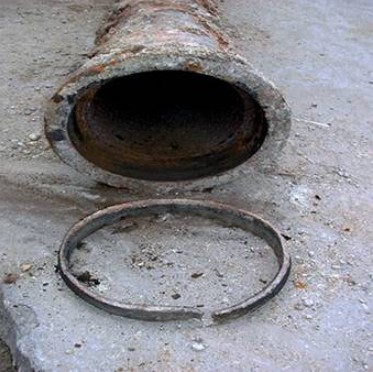
also wrote that some other ventilators were designed not only to expel the air from the pipes, but also to make proper connections, in order to water and clean the streets or fight fires. (13)
The city of Philadelphia adopted a system where from the main line of water conduction there were several derivations of less caliber, to spread the water through the entire city, connecting households to these smaller pipes at the cost of 5.00 dollars a year. He strongly suggested to Pinillos to imitate the model of management that was in use in that city, and that was a complete success. According to Campos, the aqueduct income in the year 1831 was of $ 66 766,00, investing the amount of $ 39 766,00 in new branches, with a surplus of $ 27 000,00. (13)
Most interesting is the comparison that Campos did about the high efficiency of the construction process of the aqueduct of Philadelphia, and the possibilities that having a similar one could brought to the construction of the new aqueduct in Havana. Campos wrote that one director, two deputies and ten workers, put 50 pipes of nine feet of length each, a total of 450 feet of well-constructed aqueduct every day. (13)
Last but not least, Campos explained Pinillos that in Philadelphia, like in other cities of the United States, the pipes were simply put in the bottom of the trench previously excavated on the ground, instead of the more expensive way used in Paris, similar to the one used by the Spanish constructors, that implied the erection of a mason channel in order to support and protect the pipes, previously made of led or clay. He assumed that the abundance of iron made the American engineers and other te-
chnicians not to worry about the oxidation of the pipes, so they could replace them very easily, saving a lot of time, energy and money along the process. (13)
A very important issue for the requirements of the aqueduct in Havana was the construction of filters. According to Campos, the inhabitants of Philadelphia drank dirty water during the season of rains, the only flaw of the aqueduct. He was informed that the city of Richmond was building its aqueduct, and they were constructing filters of sand and pebbles, but he also knew that the chief engineer of the aqueduct of Philadelphia, Mr. Graff, consulted about this issue disapproved such filters, because he thought that they were not able to produce enough water to fill the pipes of 11 inches in diameter. Taking into consideration the advice of Mr. Graff, Campos thought that the solution to this problem was adopting the kind of filters used in the paper industries, made out of wool, so he was proposing its use in Havana (13). Nevertheless, the final decision of using the filters of sand and pebbles came to Manuel Pastor in his condition of main engineer of the works and we must remember that the starting point of construction of the aqueduct was the building of the filters. The decision of using the filter of sand and pebbles influenced directly in the success of Fernando VII aqueduct by diminishing the amount of water that it produced, 4 500 cubic meters daily, instead of the 40 000 planned; besides, the filters also proved to be inefficient regarding cleaning the water, which during the rainy season arrived to the city with a brownish color.
On August 6, 1832, the constract for the production of the iron pipes for the new aqueduct of Havana was signed in the city of Philadelphia, between Nicolas Campos and Mark Richards, who had the obligation of producing the pipes (fig.3) The contract stipiulated the production of pipes with two different diameters: 2 115 pipes of 18 inches (5 803 meters) 995 of 14 inches (2 721 meters), all of them of 9 feet in length. (14) The original project was planning to use pipes of 16 inches to carry the water from the river to a certain point, from which the line would continue with pipes of 14 inches. According to his research in the United States Campos increased the diameter of the initial section of the line to 18 inches. This first contract also stipulated the production of a certain number of branches of 18 and 14 inches and reducing pipes, but evidently the stopcocks, the ventilators, another number of pipes of different diameters, and even the faucets used in the houses in Havana were produced, at least mostly in Philadelphia, while some pipes were subcontracted in England. (14)
Even though the aqueduct was officially inaugurated on May 10th, 1835, the works kept going for a long time, in the very same way the aqueduct spread throughout the entire city. The original project was just to carry the water from the Almendares river to the main cistern of the city, something that was accomplished on October of the year 1835. There was an incompa-
tibility between the main conduct and the old and inefficient distribution system, most of them pipes of fired clay or lead, and mason channels and so the old pipes had to be replaced by new iron ones.
Initially thought to be an open aqueduct, Campos changed it to a closed one like the one built in Philadelphia, which allowed to provide flowing water inside the buildings. Anyway, the target of the work was fundamentally the inner Havana, the oldest area of the city, and the fact that it spread through the outside of the wall’s area was an important increase in the number of buildings connected to the aqueduct, affecting its efficiency. In the beginning of the 1860s the distribution system was still growing.
Lack of experience working with this new concept of plumbing brought lots of difficulties. Placing the iron pipes in trenches too close to the surface of the streets, made the lines very vulnerable; (15) the use of inappropriate diameter of pipes affected the pressure of the water inside the households, and so the number of connections in a pipe, limited to 22 in a street.
The price for the connection to the aqueduct was of 20 pesos a year for one pluma of water, ten pesos for the second pluma and five pesos for every extra pluma. (16) A pluma of water was a Spanish imprecise unit of volume equivalent to 2 200 liters a day (2,2 cubic meters) in Barcelona, but in Mataro it was of 7 405 liters a day (7,4 cubic meters). (17) With the new aqueduct the number of public fountains grew, and even when some of them enhanced the beauty of the city, several fountains were built in poor neighborhoods where people could not afford to pay the connection to the aqueduct. In 1841 the city had 58 public fountains.
In 1860 the city had 3399 privates plumas and 575 publiciones. (18) Those days the city received something around 9 000 cubic meters of water every day.
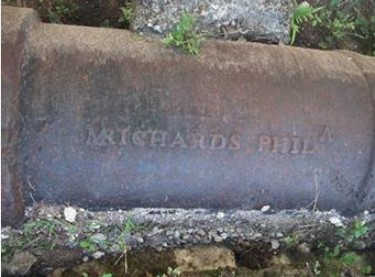
Even when the Fernando VII aqueduct improved the quality of the water that the city dwellers consumed, decreasing the number of cases of cholera, the Board of health considered in 1849 that the water was somehow contaminated since it arrived to the city during the rainy season with a brownish color. A committee that analyzed the situation proposed to transport the water from the Vento springs to the building of the filters in order to carry it to the city (19) but it did not happen and the idea was the base for a new aqueduct.
DISCUSSION
Summing up, there is a connection between the developments of the second Water Works of the city of Philadelphia and the aqueduct constructed in Havana from the year 1832 on. In the first place, the introduction of plumbing in the city was a door opened to any future improvement in the water supply. The first project was merely to conduct the water from the Almendares river to the main cistern of the city; what was finally done was the complete substitution of the old way of using the water for a system of distribution throughout the city using iron pipes, like in the city of Philadelphia. The provision of flowing water to households enhanced the use of domestic devices such as faucets, sinks, baths, and showers, and impro- ved domestic sanitation, and so the hygiene at the city scale, whose first sewers were constructed soon after this aqueduct. The presence of hydrants in public places in Havana allowed to fight fires and to water the streets.
In second place, the management of Fernando VII aqueduct was successful and it was a whole new experience in Cuba, adopted by suggestion of Nicolas Campos, inspired in the city of Philadelphia. Between 1845 and 1853, the income of the aqueduct was $ 228 000,00, and the expenses were $ 92 400,00, with a profit of $ 135 600,00; between 1985 and 1859, the net profit was of $ 356 000,00. (18)
The industrial revolution produced a change in the use and management of water and the second Water Works of Philadelphia are a good example of it, with a combination of technology and nature. It was the first municipal waterworks in the United States of America. Nowadays the Fairmount Water Works is a major attraction in the Fairmount Park, with an Interpretive Centre for the history of the water supply of the city. The place is registered as a National Historic Landmark because it is “an engineering triumph as well as an architectural treasure”. (8)
In Cuba the construction of Fernando VII aqueduct was the first step into the revolution of water, whose second step was the construction of Albear aqueduct, inaugurated in 1893 (Fig. 4); most of the iron pipes that formed the distribution system of Fernando VII aqueduct were used to distribute its water. Some of these ancient pipes are still in use in Havana almost two hundred years later as a testimony of the relationship between Phi-
ladelphia and our city and the endeavor of constructing a better aqueduct for the people.
In 2007 the National Commission of Monuments declared the System of Historical aqueducts of Havana, that includes Zanja Real, Fernando VII and Albear as a National Monu- ment. By that time the dam and the filters building practically disappeared and some other remains are also in danger, even when still functioning.
Acknowledgement
In the memory of my friend Humberto Telleria. I wish to acknowledge the cooperation of the specialists of the National Archive of Cuba
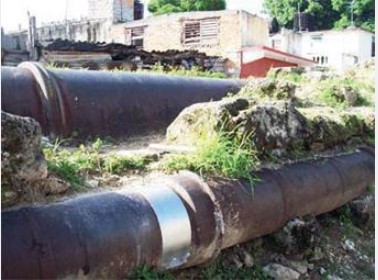
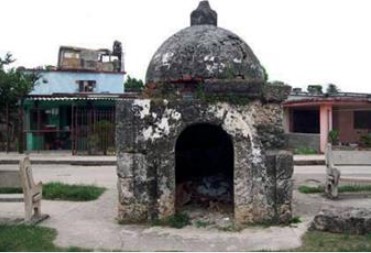
BIBLIOGRAPHIC REFERENCES
1. Philadelphia Water Department. Water and Drainage History Course, Module 2: Philadelphia: Colonial Settlement to U.S. Capital, 1682-1801. 2015. At Philly h2o.org. [Consulted on Dec 23rd 2017]
2. Morris A. Pierce. Documentary History of American Water-works. 2015. At www.waterworkshistory.us/PA/Philadelphia/[Consulted on Jun 11th 2019].
3. Philadelphia Water Department. Water and Drainage History Course, Module 3: Philadelphia’s First Water Distribution System: Centre Square, 1801-1815. 2015. At Philly h2o.org. [Consulted on Dec 23rd 2017].
4. Philadelphia Water Department (2015) Water and Drainage History Course, Module 4: Philadelphia’s First Water Distribution System: Centre Square, 1801-1815. At Philly h2o.org. [Consulted on Dec 23rd 2017].
5. Philadelphia Water Department (2015) Water and Drainage History Course, Module 5: Second Philadelphia Water Works: Steam Power and Water Power at Fairmount, 1815-1909. At Philly h2o. org. [Consulted on Dec 23rd 2017].
6. Benjamin Silliman (Ed.) The American Journal of Science, and Arts. VI: 375-6. 1823, New Haven.
7. Miller, Lynn. Fairmount Water Works. Enciclopedia of Greater Philadelphia. Rutgers University. 2016. At philadelphiaencyclopedia. org [Consulted on Dec 23rd 2017].
8. Wang, Michael. Cool, clear water: The Fairmount Water Works. 2010. At https://pabook.libraries. psu.edu. [Consulted on Jul 5th 2017]
9. Arduengo García, Darwin A. “La Zanja Real esta agua trajo” Opus Habana Volume XV / 2: 24-33 Oficina del Historiador de la Ciudad de La Habana. 2013.
10. National Archive of the Republic of Cuba. Fondo Intendencia General de Hacienda, Legajo 325, Número de orden 4
11. National Archive of the Republic of Cuba. Fondo Intendencia General de Hacienda, Legajo 325, Número de orden 19.
12. National Archive of the Republic of Cuba. Fondo Gobierno Superior Civil, Legajo 376 Número de orden 14368
13. National Archive of the Republic of Cuba. Fondo Intendencia General de Hacienda, Legajo 325, Número de orden 23
14. National Archive of the Republic of Cuba. Fondo Intendencia Ge- neral de Hacienda, Legajo 325, Number 27
15. National Archive of the Republic of Cuba. Fondo Intendencia General de Hacienda, Legajo 325, Número de orden 62
16. National Archive of the Republic of Cuba. Fondo Gobierno Superior Civil, Legajo 378, Número de orden 14432
17. Museo de Historia de Barcelona. La revolución del agua en Barcelona. Agua corriente y ciudad moderna 1867-1967. 2011. p 11
18. Marrero, Leví. Cuba: Economía y Sociedad. Tomo 14. Editorial Playor, Madrid. ISBN-84-359-0128-9. pág. 156. 1988
19. National Archive of the Republic of Cuba. Fondo Gobierno Superior Civil, Legajo 378, Número de orden 14433
Author notes
darwinant21@gmail.com

